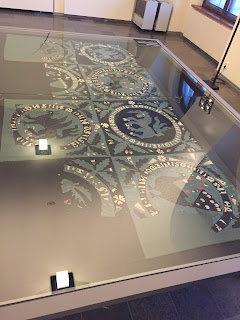I took a class on the subject of wool on wool applique at Estrella War taught by Bernadette de Costa Tempestad and when I posted the resulting make and take, I got mobbed with requests to share the handout. There was not a handout as such, so this is a compilation of notes. The instructor had some great references, and I have a few more I have from my own applique classes. Additionally, I took a class on intarsia applique taught Unna Hjalmirsdottir (I was the only attendee, so we mostly geeked out together.) Intarsia is also a wool technique that I find to be very similar to nomadic rug applique techniques and was mentioned by Bernadette in her class as well. I'm heavily interested in applique of all kinds as well as working with wool, so I'll be combining the various information. That said, it is obviously how I have interpreted the information, mixed and matched with what was swimming about in my head, so I'm sure I have missed a lot from the original class and added weird detours of my own.
 |
| Dalhem textile |
 |
| Via |
Lets start with the intarsia applique, as I have links to tutorials. The best known of the extant pieces are the inlaid woolen coverlets/ intarsia wallhangings/altar coverings from Dalhem, and Skepptuna which are held by the Historiska Museet in Sweden Inventory #23022 dated 1350-1499.
A recent reconstruction of the Masku was done by a team of 16 headed by Elina Sojonen (blogging at http://www.neulakko.net/ )and Mervi Pasanen (blogging at http://hibernaatio.blogspot.se/ ) The original and the recreation were then exhibited together in Finland at the National Museum in Helsinki. There is quite a bit of analysis of this and a how to on doing this style of applique at https://historicaltextiles.org/category/embroidery/ It is a different style as it doesn't involve pieces being put on top of one another, but rather them being cut and fitted together like a puzzle and then whip stitched in place. Then strips of gilded leather are couched over the seams. The imagery is ridiculously fun and of the type we often see on SCA "Norse Coats." The actual time period it comes from is far outside the Viking age, but I can't help adoring it. Especially as there is a gryphon that I must, must do at some point. And a peacock. It screams to be Artemisian.
 |
| Skokloster Cushion |
 The how to at Historical Textiles.org is pretty complete, as the technique isn't difficult so I'm not going to post a tutorial of my own unless someone needs further help.. You cut the pieces, which then create mirror images, as you can see from my in process pieces below and the poppies, So a grey background gets a red leaf and a red background gets a grey leaf. You tack it in a few places (or the teacher in my class used scotch tape) then whipstitch it into place. There is no backing fabric, so you end up with a single layer of wool. Then the leather strips are couched into place over the seams. You can see a small strip of gilded goatskin leather being couched down in my in process photo.
The how to at Historical Textiles.org is pretty complete, as the technique isn't difficult so I'm not going to post a tutorial of my own unless someone needs further help.. You cut the pieces, which then create mirror images, as you can see from my in process pieces below and the poppies, So a grey background gets a red leaf and a red background gets a grey leaf. You tack it in a few places (or the teacher in my class used scotch tape) then whipstitch it into place. There is no backing fabric, so you end up with a single layer of wool. Then the leather strips are couched into place over the seams. You can see a small strip of gilded goatskin leather being couched down in my in process photo.I'll get to working on assembling links for the next type of wool applique: wool on wool roundels like the ones we did in Bernadette's class and hopefully post that tomorrow.

awesome sauce thanks for sharing
ReplyDelete